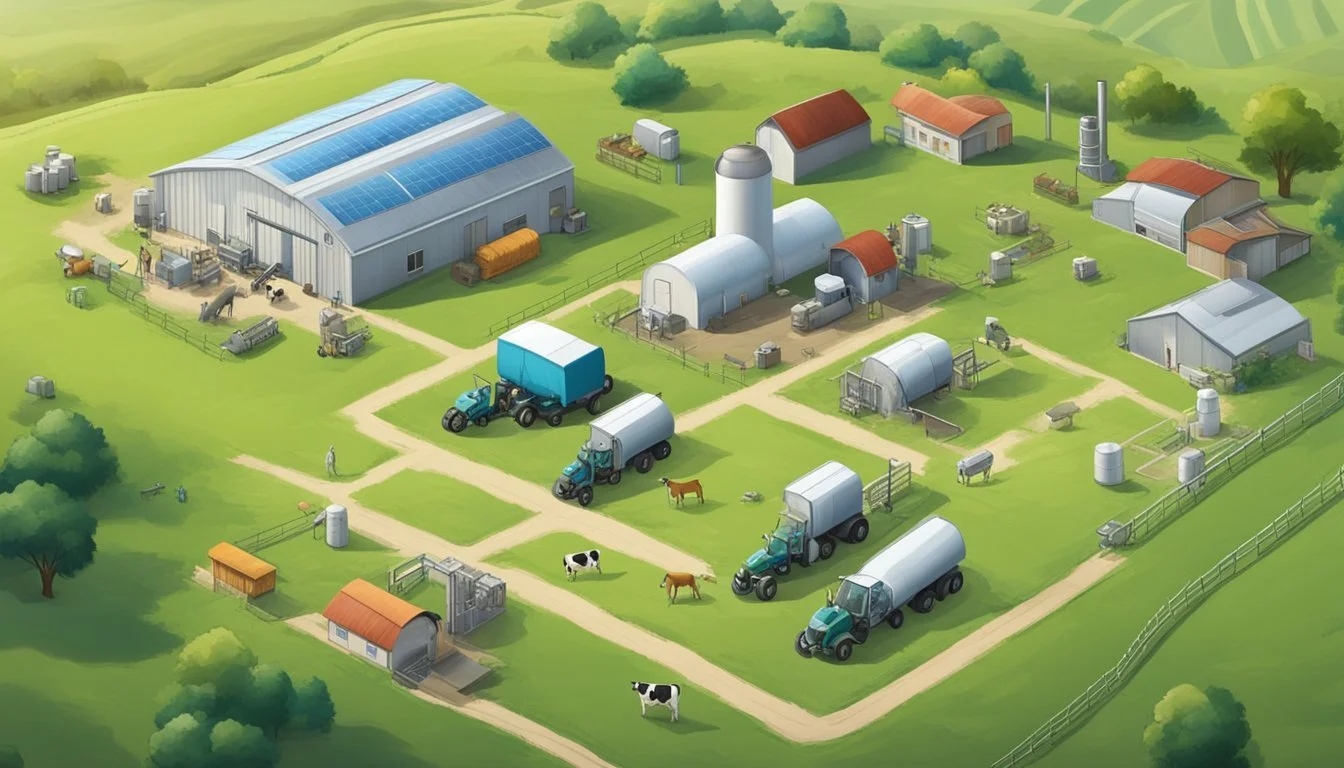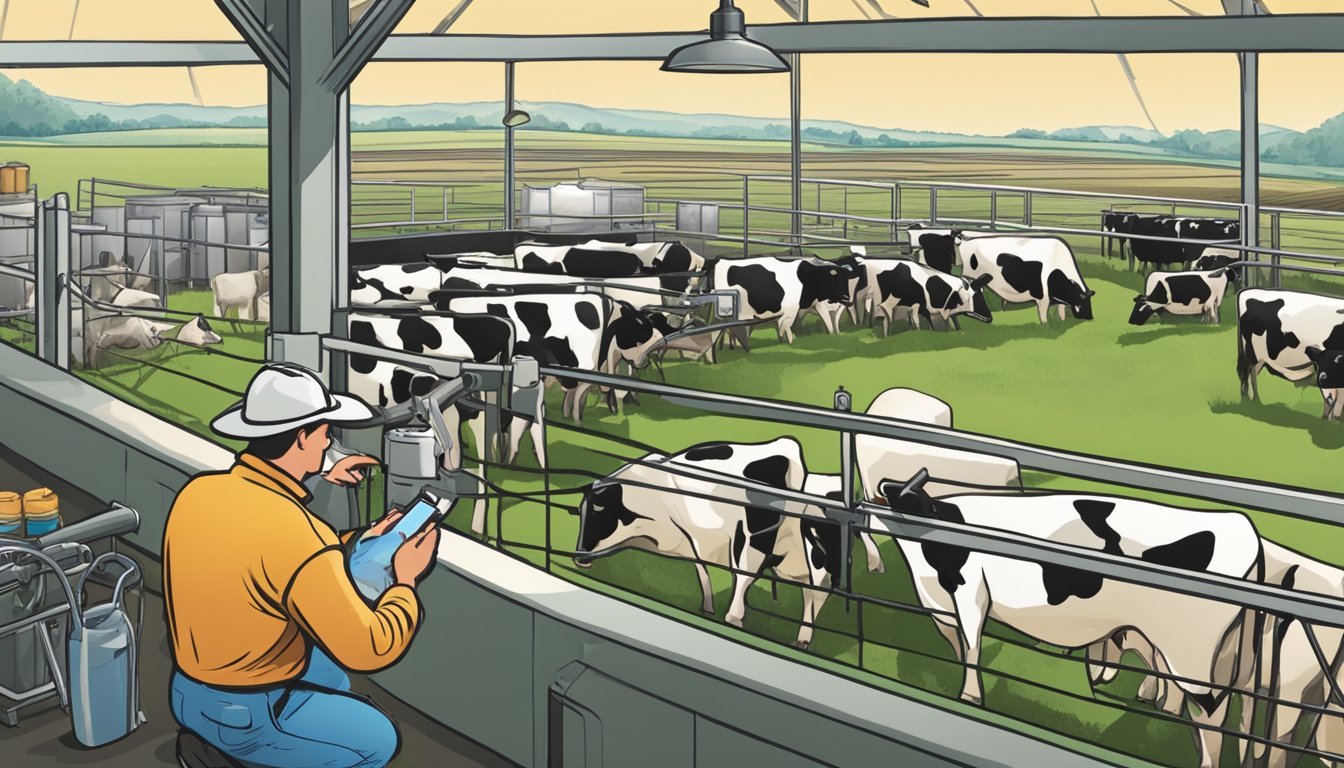How do I Manage a Small Dairy Operation
Essential Tips for Success
Managing a small dairy operation requires a multifaceted approach, blending careful animal husbandry with astute business management. Small dairy farms are integral to the agricultural landscape, offering an opportunity for entrepreneurs to produce milk, cheese, yogurt, and other dairy products on a scale that is often more sustainable and less industrial than larger counterparts. To ensure the profitability of a dairy farm, it is crucial to focus on high-quality animal care, efficient production processes, and savvy market positioning.
Key aspects of dairy farm management include the selection of suitable dairy breeds, maintaining animal health, and ensuring optimal nutrition. Moreover, the ability to manage resources effectively, adhere to food safety regulations, and implement sound financial planning can't be overstated. It is essential for dairy farmers to stay informed of the latest agricultural practices, market trends, and technological advancements that can enhance operational efficiency and productivity.
In practice, successful management involves a balancing act between optimizing milk production and minimizing expenses to ensure a profitable dairy farm. Attention to the nuances of dairy farming, from the pastures where cows graze to the meticulous process of milk pasteurization, can distinguish a well-run operation from the competition. By focusing on these key elements, those managing small dairy operations can thrive, even in a market that is as challenging as it is rewarding.
Understanding Dairy Farm Fundamentals
When embarking on managing a small dairy operation, one must understand the core aspects that affect the productivity and sustainability of the farm. This includes knowledge of infrastructure size, livestock types, and the essentials for daily operations.
Dairy Farm Size and Infrastructure
Size plays a critical role in determining the land, barn, and parlor needs of a dairy farm. An optimal size should provide adequate space for cows, allowing for comfort, movement, and effective manure management. Infrastructure considerations include a sturdy milking parlor, reliable milking equipment, and efficient milk cooling systems to preserve milk quality. Proper ventilation and shelter are also paramount in maintaining animal health and milk production levels.
Land: Essential for grazing, feed cultivation, and waste management.
Barn: Provides shelter, must facilitate ease of access for animals and workers.
Milking Parlor: Central hub for milking operations, designed for efficiency and cow comfort.
Milk Cooling: Critical in preserving milk quality directly after milking.
Types of Dairy Cows and Breeding
Selecting the appropriate breeds of dairy cows is a foundational decision. Different breeds, such as Holstein, Jersey, or Guernsey, have varying milk production capacities, butterfat content, and adaptability to climate conditions. Breeding programs should aim for genetic improvement, cow welfare, and long-term productivity.
Holstein: Known for high milk yield.
Jersey: Higher butterfat content in milk.
Breeding: Strategic mating can result in healthier and more productive herds.
Basic Requirements for Dairy Operations
Effective dairy operations necessitate facilities that meet animal welfare regulations and enhance production efficiency. Key requirements include:
A well-designed milking parlor to streamline the milking process.
Milking equipment that ensures hygiene and animal comfort.
Adequate milk cooling facilities to maintain quality before transportation.
Infrastructure that provides adequate space and comfort for the dairy herd, promoting health and production.
Good management practices and a clear understanding of these dairy farm fundamentals are vital for the success of a small dairy operation.
Dairy Herd Management and Care
Effective dairy herd management and care are essential for the health and productivity of dairy cattle. This includes focused attention to feeding, health care, and reproductive processes to ensure the well-being and efficiency of the dairy operation.
Feeding Programs and Nutrition
The foundation of a productive dairy farm lies in developing a balanced feeding program. Dairy cows require a diet that includes the right mix of hay, grain, and a consistent water supply to meet their nutritional needs, which vary according to their lactation stage and overall health. A focus on high-quality forage and the strategic use of supplements helps in maintaining optimal milk production and animal health.
Health and Veterinary Care
Routine health check-ups and timely veterinary care are vital components of dairy management. Farm managers should establish a routine that includes regular vaccinations, deworming, and treatment of illnesses. Prompt attention to health issues not only prevents the spread of disease but also minimizes discomfort and stress among the animals, which is crucial for the welfare of the dairy herd.
Reproduction and Calving
Careful management of reproduction and calving is key for the sustainability of a dairy operation. This includes monitoring heat cycles and ensuring timely and effective breeding strategies. Post-calving care is crucial for both cows and their calves to ensure their survival and well-being, setting the stage for the next lactation cycle and future herd replacements.
Milk Production and Quality Control
Efficient milk production and stringent quality control are vital for operating a small dairy. Ensuring the utmost quality of milk necessitates attention to detail in various procedures and regulatory standards.
Milking Procedures
The milking process begins with adequate preparation which includes ensuring that udders are clean and the animals are calm. During milking, it's critical to use properly sanitized equipment. Consistency in the milking routine helps in maintaining steady milk production and prevents stress to the dairy animals.
Sanitation and Health Standards
Maintaining high health standards involves regular veterinary checks and a keen eye for the well-being of the dairy herd. The use of approved cleaning agents is imperative in the sanitation process of the milking equipment, as well as the environment the dairy animals inhabit—preventing the contamination of raw milk.
Milk Storage and Handling
After milking, it's essential to cool the milk promptly to reduce bacterial growth. Milk should be stored at temperatures below 4°C (39.2°F) in clean, stainless steel containers to ensure quality is preserved until processing. Proper milk handling techniques are crucial to avoid spoilage and ensure the product remains safe for consumption.
Regulatory Compliance
Every dairy operation must comply with local, regional, and national regulations governing the dairy industry. These often include obtaining the necessary permits, adherence to quality standards for raw milk, and engaging in regular testing to fulfill safety protocols. Compliance is not optional; it's essential for legal operation and ensuring public health safety.
Financial Management of a Dairy Farm
Effective financial management is crucial for the sustainability and profitability of a dairy operation. Addressing budgeting, income, cash flow, and risk management enables farmers to make informed decisions, ensuring economic stability and steady profits even in the volatile market.
Budgeting and Managing Expenses
To ensure profitability, it is essential for dairy farmers to maintain a strict budget that accurately reflects all expenses. This includes feed, labor, veterinary costs, and equipment maintenance. Utilizing tools like QuickBooks for managing dairy finances can aid in tracking and controlling costs. Farmers must stay abreast of market trends to anticipate fluctuations in input prices and adjust their budgets accordingly.
Understanding Income and Cash Flow
Income for dairy farms comes primarily from the sale of milk and may be supplemented by the sale of calves, culls, and manure. A clear understanding of cash flow involves recognizing not only when income is generated but when expenses occur. The timing of these transactions can significantly impact the operation’s liquidity. Effective cash flow management ensures that a dairy farm has the funds necessary to cover short-term obligations and make strategic investments.
Risk Management and Insurance
Risk management in dairy farming involves strategies that stabilize income and manage expenses against unforeseen events. Implementing risk management tools like Dairy Margin Coverage provides a safety net against declining dairy margins. Comprehensive insurance plans protect against property losses and liability issues. Additionally, strategically servicing and repaying loans is crucial to avoid financial strain from high-interest rates or unfavorable loan terms.
Marketing and Sales Strategies
Effective marketing and sales strategies are crucial for the success of a small dairy operation. It is essential to understand and capture market demand, develop a strong brand presence, and explore opportunities with value-added dairy products.
Identifying Market Demand
To successfully market dairy products, one must first assess consumer demand within the market. This involves analyzing trends and preferences regarding dairy products such as cheese, butter, yogurt, ice cream, buttermilk, and sour cream. Understanding which products are in high demand can guide production and inventory decisions. Small dairy operations can benefit from gathering data on local preferences and seasonal demands to tailor their offerings accordingly.
Branding and Product Promotion
Building a recognized and respected brand is vital for differentiating dairy products in a competitive market. A strong brand communicates the quality and origin of products such as artisanal cheese or organic butter. Promotion strategies should emphasize unique attributes, such as a commitment to sustainability or the use of traditional techniques. By emphasizing these characteristics, customers are more likely to remember the brand and opt for its products.
Value-Added Dairy Products
Introducing value-added dairy products can significantly enhance profitability for small dairy operations. This can include specialty items like flavored yogurts or high-quality artisanal cheeses that command a higher price point. Additionally, creating unique offerings such as seasonal ice cream flavors or cultured buttermilk can attract a niche market segment. It is important for producers to consider how value-added products can fit into their existing production capabilities and market demands.
Operational Efficiency and Sustainability
To effectively manage a small dairy operation, it's critical to focus on operational efficiency and sustainability. These approaches help in reducing costs and environmental impact while maintaining productivity. Through smart farm practices, conscientious environmental management, and effective waste manure handling, dairy operators can foster a thriving, future-proof business.
Implementing Efficient Farm Practices
Dairy operations can significantly improve their efficiency by harnessing the latest dairy equipment and technologies. For example, milking systems and milk cooling equipment that are regularly maintained optimize performance and reduce downtime. Small changes, such as installing variable speed drives on vacuum pumps, can lead to significant energy savings. Creating strict feeding protocols ensures that you are feeding the cows efficiently, which can lower feed costs while maintaining milk production.
Environmental Management
Managing the environmental impact of a dairy operation begins with efficient use of resources. Monitoring water usage and implementing water-saving practices are essential. Additionally, energy conservation efforts like utilizing renewable energy sources can play a pivotal role. Farms should also consider the carbon footprint of their operation and explore opportunities for carbon sequestration or participation in carbon credit markets.
Waste Management and Manure Handling
Effective waste management is key to running a sustainable dairy farm. Proper manure management not only prevents environmental contamination but also turns waste into a valuable asset. For instance, manure can be processed through a digester to produce biogas, which can be used as a renewable energy source. Manure can also be composted and used as a natural fertilizer, improving soil health and reducing chemical fertilizer use. Implementing systematic manure collection and storage is crucial to optimize these processes and keep the operation both clean and compliant with regulations.
Planning and Development
In managing a small dairy operation, laying out a detailed plan and proactively adjusting to changes are critical steps. They ensure a solid business framework and pave the way for future opportunities.
Business Planning and Strategy Formulation
A well-crafted business plan is the foundation of any successful dairy operation. It serves as a roadmap, detailing financial projections, marketing strategies, and operational procedures. Tools for Developing a Business Plan for a Dairy Operation can guide producers through this process. The plan should encompass the knowledge of agriculture experts to address all angles, from feed management to product marketing. Engaging with experienced consultants can provide a fresh perspective and innovative strategies that align with industry best practices.
Expansion and Growth Opportunities
For dairy producers looking to grow their business, identifying expansion opportunities is key. This could include diversifying product lines, upgrading technology, or increasing herd size. However, it's important to align growth with market demand and operational capacity. A growth strategy might consider leveraging resources, like the Creating a Dairy Farm Operating Plan, that suggests keeping a blueprint for farm scaling readily accessible for involved stakeholders.
Navigating Industry Changes and Challenges
The dairy industry does not exist in a bubble; it's subject to external changes and challenges, such as Covid-19 and shifts in consumer preferences. A dairy operation must adapt to these influences, which could mean implementing biosecurity measures in response to pandemics or embracing sustainable farming practices to meet market trends. Resources like Operational Planning - Progressive Dairy can offer insights into how dairy businesses can navigate such changes effectively. It's important that they stay informed about industry changes through continued learning and adapt their business plan accordingly.
People and Communication
Managing a small dairy operation requires attention to labor and communication. This involves strategically hiring workers, building a cohesive team, and developing robust communication strategies that support the day-to-day activities in the office and beyond.
Hiring and Labor Management
When it comes to hiring and labor management, a small dairy operation should prioritize candidates who are not only skilled but also demonstrate a positive attitude and strong work ethic. The management's role is crucial in hiring the right individuals. They must ensure that the employees understand the culture of respect and open communication critical for the safety and well-being of the animals and their coworkers.
Training and Team Building
Training and team building are essential for high-performing teams. Dairy managers with leadership abilities are instrumental in creating workplace cultures that foster team cohesion and motivation. To manage milk quality effectively, they require ongoing management training that focuses on employee communication, workflow management, and the development of a farm's ethos.
Effective Communication Strategies
Implementing effective communication strategies in a small dairy requires clarity and consistency. Whether it's between employees or with the reiteration of safety protocols, communication needs to be streamlined through various methods like staff meetings, written memos, or digital communication tools to ensure everyone is informed and can carry out their duties effectively. A proactive approach to communication planning also prepares the operation to handle any issues that may arise swiftly.
Understanding Dairy Markets and Pricing
Managing a small dairy operation requires a solid grasp of dairy markets and how milk pricing can be influenced by various factors. This section breaks down the complexity of the market analysis and milk price fluctuations, the supply chain process up to the final point of sale, and the cultivation of robust business relationships that underpin a successful dairy business model.
Market Analysis and Milk Price Fluctuations
Milk market dynamics are driven by both domestic demand and global dairy trade pressures which can cause milk prices to fluctuate. Operators must track these changes to forecast revenue and plan accordingly. They should analyze historical price trends as well as monitoring current and historical dairy market information to understand how supply and demand can impact their business.
Supply Chain and Processing
In the processing stage, efficiency converts the raw milk into products ready for the market. Dairy farming relies heavily on a well-coordinated supply chain – from feed suppliers to milk processors. It's crucial to understand that every step in this process can affect pricing. Small operations should focus on creating a streamlined system to keep costs manageable and maintain—or improve—their competitive position in the market.
Developing Strong Business Relationships
Long-lasting relationships with suppliers, customers, and other stakeholders are key to a thriving operation. They can provide more stable pricing agreements and a reliable supply chain, which is essential for small dairies managing tight margins. Learning from industry experts with decades of experience can help build the foundation of these relationships and understand the intricacies of market policy, practices, and pricing.
Legal and Administrative Aspects
Managing a small dairy operation involves navigating a complex web of legal requirements and administrative tasks to ensure compliance and operational efficiency. Dairy farmers must be diligent in addressing the legal and administrative sides of business to avoid potential penalties and disruptions.
Acquiring Necessary Licenses and Permits
Licenses and Permits: Dairy operations require various licenses and permits related to animal health, food safety, and environmental regulations. They must obtain a dairy plant license if they process milk, as well as a milk producer license to legally operate. Inspections may be a prerequisite to obtaining these licenses, ensuring facilities comply with state and federal standards.
Understanding Zoning and Land Use Laws
Zoning and Land Use: Dairy farmers must understand and adhere to local zoning laws which dictate where agricultural operations can be situated. They need to verify that their land is zoned for agricultural use and, more specifically, for dairy farming. Non-compliance with these laws can lead to legal conflicts and jeopardize the farm’s operations.
Maintaining Records and Compliance Documentation
Records and Documentation: Keeping meticulous records is a legal necessity for dairy operations. This includes documentation of animal health, milk production, and waste management practices. They must also maintain records of permits and inspection reports to prove ongoing compliance with various regulations. Accurate, up-to-date documentation can protect a dairy business during audits and legal reviews.








